My cash - Banknotes
Third Series of the New Shekel, 2014
The banknotes in the Third Series of the New Shekel carry the portraits of outstanding Hebrew poets whose life stories, works, and activities are intertwined with the story of the rebirth of the Nation of Israel in its land.
The banknotes in the series incorporate advanced levels of security, innovation, and accessibility.
They include a range of advanced anti-counterfeiting security features and integrate specific features to facilitate use by the blind and vision impaired.
The first denomination of the third series of the New Shekel, the NIS 50 banknote, was put into circulation in September 2014 (Elul 5774).
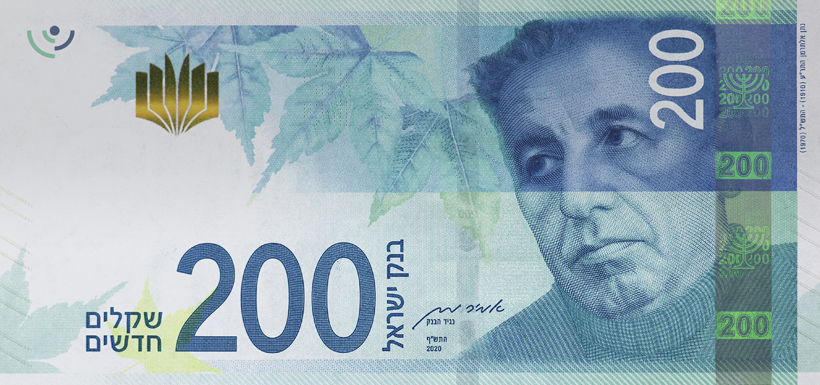
-
Portrait of
Nathan Alterman -
Designer
Ms. Osnat Eshel -
Dimensions
150mm x 71mm -
Issue date
December 2015. -
Color
Blue -
Design of edge
Moonlit flora inspired by the poem "Eternal Meeting" and an excerpt from the poem “Morning Song”.
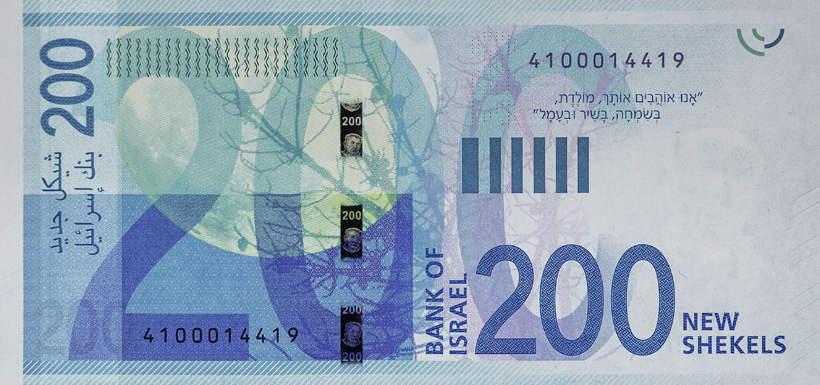
-
Portrait of
Nathan Alterman -
Designer
Ms. Osnat Eshel -
Dimensions
150mm x 71mm -
Issue date
December 2015. -
Color
Blue -
Design of edge
Moonlit flora inspired by the poem "Eternal Meeting" and an excerpt from the poem “Morning Song”.

Nathan Alterman (1910-1970), one of the greatest modern Israeli poets, was also a translator, journalist, playwright, and songwriter. Born in Warsaw, Poland, he immigrated to Israel with his family in 1925 and settled in Tel Aviv. Alterman was awarded numerous prizes for his literary works and translations, among them the Tchernichovsky Prize for Outstanding Translations (1946, 1968), the Ruppin Prize (1947), the Bialik Belles-Lettres Prize (1957), and the Israel Prize for Literature, for his lifetime achievement (1968).
Alterman’s writing is rich and variegated. It includes Hebrew poetry, plays, songs, and children’s songs alongside contemporary issues and prose. His writing strongly influenced modern Hebrew poetry and is considered innovative and groundbreaking. His first book of poems, Stars Outside, was first published in 1938 and was lauded as a great innovation in Hebrew poetry due to its language, which was rich in linguistic imagery and dual meanings that could be read into his poems. Many of Alterman’s poems are well-known. Among these are: “Still the Tune Returns” - the opening poem of his book “Stars Outside”, “Eternal Meeting”, “Preservation Song”, “Eliphelet”, “Anemones”, “Song of Three Answers” and many more. Among his better-known and more successful plays, which have been presented at the Cameri and Habima theaters, are the plays “Kinneret Kinneret”, “The Inn of Ghosts” and “King Solomon and Shalmai the Cobbler”. Besides his original writing, Alterman was a copious translator of masterpieces of world literature including children’s songs, and plays by Shakespeare, Racine, and Moliere.
The NIS 200 banknote from the third series of the New Shekel is dedicated to Nathan Alterman’s work. The note’s obverse bears the poet's portrait and the words of the poem “Eternal Meeting” in microtext. The poem was given numerous interpretations due to its ambiguity. It includes verses mentioning the forces of nature, the night, and the moon. These were the inspiration for the layout of the NIS 200 banknote, the interplay between the autumn leaves on the obverse and the moonlit flora on the reverse. A verse out of Alterman’s poem “Morning Song” also appears on the obverse: “We love you our motherland, joyously, with our song and with our labor”.
Related links and further information on Nathan Alterman:
Nathan Alterman on Wikipedia
Nathan Alterman website (in Hebrew)
Lexicon of Modern Hebrew Literature (in Hebrew)
Israeli Institute for Hebrew Literature

-
Portrait of
Leah Goldberg -
Designer
Ms. Osnat Eshel -
Dimensions
143mm x 71mm -
Issue date
November 2017 -
Color
Orange -
Design of edge
A group of does—the inspiration for her poem “What Do the Does Do?”, which is also the name of her first children’s book, and an excerpt from her poem “White Days”.
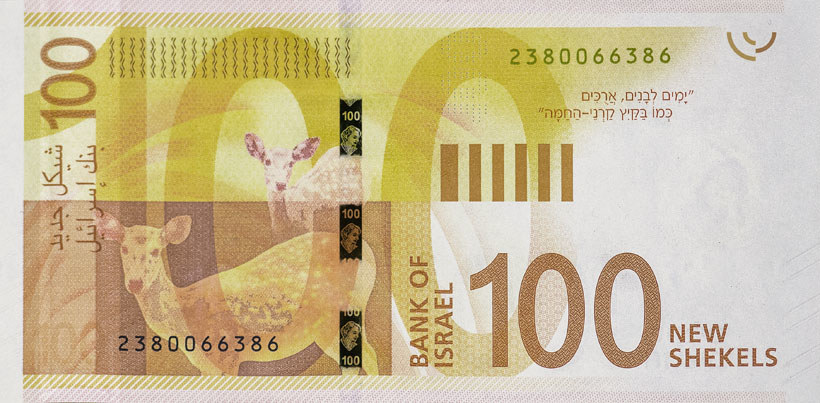
-
Portrait of
Leah Goldberg -
Designer
Ms. Osnat Eshel -
Dimensions
143mm x 71mm -
Issue date
November 2017 -
Color
Orange -
Design of edge
A group of does—the inspiration for her poem “What Do the Does Do?”, which is also the name of her first children’s book, and an excerpt from her poem “White Days”.

Leah Goldberg (1911–1970), was one of Israel’s most important and outstanding poetesses. She also wrote fiction and plays, translated, edited, taught, wrote critiques and engaged in research. Goldberg was born in Koenigsberg, Prussia (in today’s Russia) and grew up in Kaunas, Lithuania. She completed her doctoral thesis in 1933 in Semitic linguistics, and immigrated to pre-Israel Palestine in 1935.
Goldberg’s poetry is contemplative, her language clear. Her works deal with intimate, personal issues and include descriptions of Israeli and European landscapes. Much of Goldberg’s work deals with the legacy from her life in Europe and with the Holocaust and its impact on her generation. Many of her poems have been set to music, among them “Is It True?”, “Atonement”, “The Love of Theresa di Meun” (“From My Window and Yours”), “Evening Opposite the Gilead” (“The Trees Are So Heavy”) and “The Hyacinth’s Song”. Goldberg wrote and edited numerous children’s books—among the most well-known are “Apartment for Rent”, “The Absent-Minded Man from Kfar Azar”, and “Where is Pluto”. Besides writing, Goldberg was involved in numerous related pursuits. She translated classics from world literature, including Tolstoy, Chekhov, Shakespeare, and Ibsen. She also edited newspapers and children’s books, taught, and served as professor of general and comparative literature at Hebrew University. Goldberg’s writings earned her the Rubin Prize in 1949, and in 1970—posthumously—she was awarded the Israel Prize for literature.
The NIS 100 banknote from the third series of the New Shekel is dedicated to Leah Goldberg’s work. The obverse bears her portrait against a background of almond blossoms, beside which in microtext is the poem entitled “In the Land of my Love the Almond Tree is Blooming”. The reverse depicts a group of does—the inspiration for her poem “What Do the Does Do?”, which is also the name of her first children’s book. The reverse also contains an excerpt from the poem “White Days, As Long As the Summer Rays of the Sun”.

-
Portrait of
Shaul Tchernichovsky -
Designer
Ms. Osnat Eshel -
Dimensions
136mm x 71mm -
Issue date
September 2014 -
Color
Green -
Design of edge
A Corinthian style column and lines from Shaul Tchernichovsky’s poem “I Believe”.
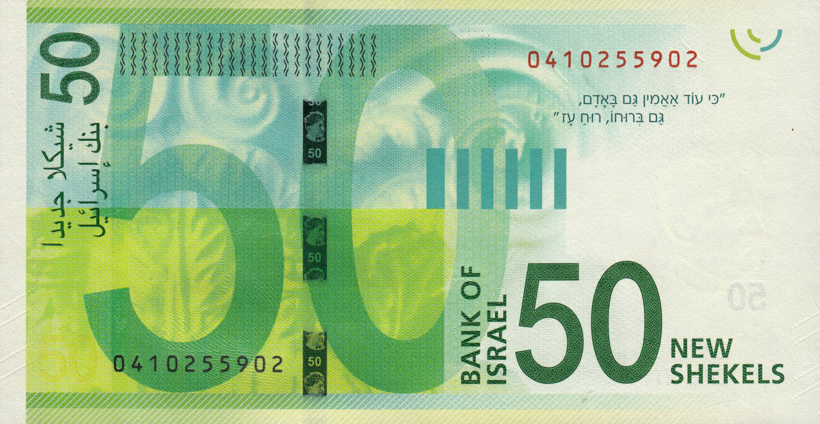
-
Portrait of
Shaul Tchernichovsky -
Designer
Ms. Osnat Eshel -
Dimensions
136mm x 71mm -
Issue date
September 2014 -
Color
Green -
Design of edge
A Corinthian style column and lines from Shaul Tchernichovsky’s poem “I Believe”.

Shaul Tchernichovsky (1875-1943), was one of the greatest Hebrew poets of the first half of the 20th century, as well as a translator and a doctor. He was born near the Ukraine border and immigrated to the Land of Israel in 1931. He studied medicine, and after his graduation—and for the rest of his life—combined his work as a doctor and his work as a poet.
Tchernichovsky’s poetry is prolific and diverse, blending influences of both Jewish and world culture. In his work he was influenced by landscapes of his native country, Greek culture, the land of Israel and the Bible. Poems like “I Believe”, “They Say There is a Country” and “Oh, My Land, My Birthplace” reflect his relation to Zionism, the Jewish people and the land of Israel. These poems, like many others such as “I Have a Garden”, “Lily of Wonders” and “I Don’t Love Her” were put to music and performed by some of the best Hebrew performers. Tchernichovsky was also known as an excellent translator and was responsible for the translation into Hebrew of classical masterpieces.
The design of the NIS 50 banknote in the third series of the New Shekel reflects the rich and diverse poetry of Tchernichovsky and his relation to the land of Israel, along with his embrace and comprehensive knowledge of world culture. The obverse of the banknote carries his portrait and the lyrics of his poem “Oh, My Land my Birthplace” in microtext, which inspired the incorporation of a citrus tree with fruits in the design of the banknote. The reverse of the note incorporates a Corinthian-style column, reflecting Tchernichovsky’s interest in classical Greek works. A sentence from Tchernichovsky’s poem “I Believe” is printed on the reverse of the banknote: “For I shall still believe in both Man and his spirit, a fierce spirit”.
Links and further information about Shaul Tchernichovsky:The National Library of Israel
CET (The Center for Educational Technology)
Project Ben-Yehuda
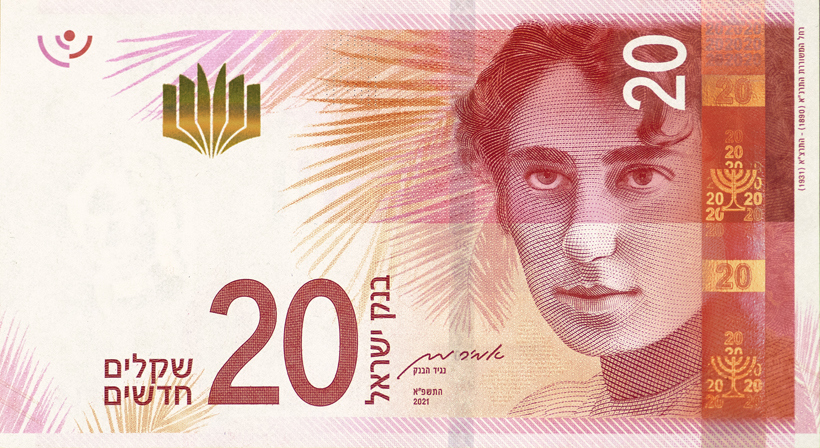
-
Portrait of
Rachel the Poetess -
Designer
Ms. Osnat Eshel -
Dimensions
129mm x 71mm -
Issue date
November 2017 -
Color
Red -
Design of edge
A typical landscape of the Sea of Galilee, inspired by her poem “Kinneret”, and an excerpt from her poem, “Perhaps it was Never so”. Features for the blind and vision impaired: A pair of lines printed in raised ink, along both the left and right edges of the banknote, near the bottom.

-
Portrait of
Rachel the Poetess -
Designer
Ms. Osnat Eshel -
Dimensions
129mm x 71mm -
Issue date
November 2017 -
Color
Red -
Design of edge
A typical landscape of the Sea of Galilee, inspired by her poem “Kinneret”, and an excerpt from her poem, “Perhaps it was Never so”. Features for the blind and vision impaired: A pair of lines printed in raised ink, along both the left and right edges of the banknote, near the bottom.

Rachel the Poetess (Rachel Bluwstein, 1890–1931) is among the most prominent and well-known Hebrew poets, and is regarded by many as foremost among them. Her poetry has earned a place of honor in Hebrew culture and she is beloved by many generations of readers.
Rachel was born in Saratov, a city on the frontier of the Russian empire, to a Zionist family. She immigrated to pre-Israel Palestine in her youth. Rachel first settled in the city of Rehovot and later moved to Havat Ha’Alamot, a women’s farm, on the shores of the Sea of Galilee. She later moved to the Kibbutz Deganya, where she was diagnosed with tuberculosis, a disease which at the time was considered terminal, and which ultimately caused her untimely death.
She began writing in her youth in Russian. Her work was influenced by the Bible, contemporary pioneer literature, and sources and schools in Russian and French literature. Her poetry is remarkable for its simplicity and its succinct language. It expresses her loves, her disappointments, her pains, and her fears. It is replete with allusions to her short, tragic life; a large portion of it deals with awaiting death. Among her most famous poems are “Only About Myself”, “To My Land”, “Encounter, Barely an Encounter”, “Kinneret” (“Yonder are the Golan Mountains”), “Sad Song” (“Do You Hear My Voice”), “Sealed Garden”, “Gift”, and others. Many of her poems have been set to music and have been performed posthumously by Israel’s leading artists. Over the years they have become indispensable pillars of Israeli culture and poetry.
The design of the NIS 20 banknote in the third series of the New Shekel evokes Rachel’s poetry and the landscapes of her life. The obverse bears her portrait against a background of palm fronds, beside which in microtext is the poem “Kinneret”—the inspiration for the design of the banknote’s reverse. The reverse depicts a landscape from the Sea of Galilee, the lake of which Rachel wrote many poems and on whose shores she wished to be buried. In addition, the reverse bears an excerpt from “Perhaps it Never Happened...”: “O my Kinneret, Were you, Or was I dreaming?”
Catalog of banknotes
Bank of Israel cash desk
The Currency Department provides a money-changing service to the public, for exchanging Israeli currency for larger or smaller denominations, at the cash desk in the Bank of Israel's Jerusalem headquarters. Damaged currency can also be changed at the cash desk. The cash desk is open to the public:
Sunday through Thursday, 8:00–13:00
Address: 2 Eliezer Kaplan Street, Kiryat Ben-Gurion, Jerusalem.
Phone: 02-655-2847
Please arrange your appointment in advance.
Public Enquiries for the Currency Department
For public enquiries relating to currency: contact_currency@boi.org.il
Phone number: +972-2-655-2874

Accessibility In The New Bank Notes
The issue of accessibility in general, concerning all populations, was a major consideration for the Bank of Israel throughout the planning of the new series of banknotes, and will continue to be a priority in the future. Because of the importance attached by the Bank of Israel to the subject of accessibility in general, and its application to the blind and vision impaired in particular, the Bank has acted to increase the accessibility of the new series of banknotes.











